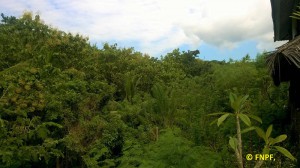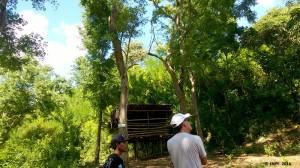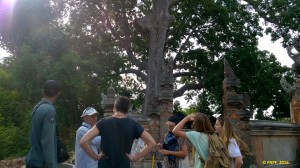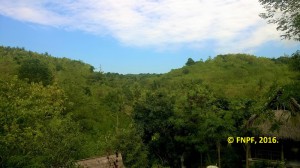David Donato, a consultant from Australia found paradise for bird watchers on a small island at the South of Bali, Indonesien.
Nusa Penida: Birding Adventure
By David Donato.
Mellem 4 og 15 April 2016, I visited Nusa Penida to volunteer with Friends of the National Parks Foundation (FNPF). I caught to fast boat from Bali, Sanur east of Kuta, and within an hour we berthed at Nusa Penida. I picked up a ride on the back of a motorbike (Ojek) and was taken to Yayasan Burung, FNPF new accommodation is the forest above Ped one of the main villages on the north coast of Nusa Penida.
I arrived just on dark but was made very welcome immediately on arrival and shown to my room and surrounding facilities. The accommodation was great, comfortable, clean and with a balcony backing onto a forested valley looking over the forest canopy. A great place to spot birds and fruit bats eating the papaya next the balcony. Breakfast and dinner was included in an open air restaurant, again on the edge of the forest, where I was introduced to the other volunteers – a friendly bunch. The staff friendliness and helpfulness could not be faulted.
Being a bird nut, I was keen to get into the forest the next morning. But the excitement started during the evening. While deep in sleep under the mosquito net and ceiling fan I woke to hear a scops owl (Strigidae)-type call. Although, I am not aware of any owl species on Nusa Penida. The owl calls continued on every night, but obviously different species. I managed to record every ‘owl’ call and will one day work out the different species.
Before the break of dawn, in the grey light, I could hear the morning bird chorus. It was loud, varied and close by. More varied and abundant that anyway I have been in Indonesia outside of a national park. This is to do with a FNPF and the local customs of not persecuting birds. On stepping outside and walking down the paths into the forest, it became immediately obvious to me that birds were common and not shockingly shy as they are almost everywhere in Indonesia. Zebra Dove (Geopelia striata), a species poached to local extinction elsewhere, was abundant and easily see. Same for Pink-necked Fruit Dove (Ptilinopus porphyreus), which was abundant and vocal and with patience I spotted flocks of 30 in fruiting trees. The Black-naped Fruit Dove (Ptilinopus melanospilus), probably the most beautiful fruit doves I have seen, once the call was recognized was common in diverse habitat and across the island. Within the next few days I realized that birds were common and by Indonesian standards, easy to see. I travelled across the island on motorbike, there is very little traffic, and could stop at any location walk amongst the road and tracks and find birds in abundance.
All up a total of 52 species were recorded including the much sort after Bali Starling ((Leucopsar rothschildi). The Bali Starling strikes one with its’ beauty immediately and its’ size (it is surprisingly large). It is snow white, with a crest, and black tips to tail and flight feathers. It has a brilliant blue facial skin around the eye. Only here and in Bali Barat National Park can the bird be seen in the wild, thanks to the captive release and follow up efforts of FNPF. The bird has suffered a recent decline in numbers but with targeted actions by FNPF the species will recover again.
Ecologically, Nusa Penida is very interesting. Its’ status and ecology appears in the reverse to many islands in South East Asia. The forest is growing back. The island is covered with old farm terracing and was obviously extensively cleared. But has over the last 30 til 40 years farms have been abandon, with local population gaining its income from seaweed farming for export, shifting away from terrestrial subsistence farming. The lands are not cultivated or grazed to the same extent that they once were. Derfor, the forest is growing back, rapidly across the island. This coupled with local traditional customs and efforts by FNPF, birds are not hunted, captured or harassed. This has resulted in a massive increase in bird diversity and abundance. This will only continue in years to come. Testimony to this is seeing four snakes, including a 2 meter brown snake (species unknown), and two large goannas (varanus spp.). Wildlife that would be almost impossible to see in Indonesia outside national parks.
The marine environment is probably already on the diving charter map, with corals just off the shore and Manta Rays (Manta birostris) and Moonfish (Monodactylidae) regular at known reefs.
In the future the island will be discovered by bird watchers and naturalists in general for its natural beauty and wildlife. FNPF have staff that are knowledgeable in wildlife and can guide birdos in the forest and find sort after birds. It was a remarkable experience working with FNPF to make Nusa Penida an even better place than what it is. I will return.
Written By: David Donato
Edited By : Anggi
For more information please contact.
anggi@fnpf.org










